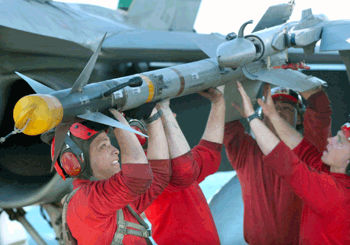
 Services: Navy, Marine Corps and Air Force
Services: Navy, Marine Corps and Air Force
Description: The AIM-9 Sidewinder is a heat-seeking, short-range, air-to-air missile carried by fighter aircraft.
Features: The Sidewinder has a high-explosive warhead and an infrared heat-seeking guidance system. Its main components are an infrared homing guidance section, an active optical target detector, a high-explosive warhead and a rocket motor. The guidance section enables the missile to home in on the engine exhaust of target aircraft. An infrared unit costs less than other types of guidance systems and can be used day or night in all weather conditions. The infrared seeker also permits the pilot to launch the missile then leave the area or take evasive action while the missile guides itself to the target.
Background: A prototype of the Sidewinder, the AIM-9A, was first fired successfully in September 1953. The initial production version, designated AIM-9B, entered operational use in 1956 and has been improved upon steadily since. The L model was the first Sidewinder with the ability to attack from all angles, including head-on. The AIM-9M, currently the only one operational, has the all-aspect capability of the L model while providing all-around higher performance. The M model has
improved defense against infrared countermeasures, enhanced background discrimination capability, and a reduced-smoke rocket motor. These modifications increase its ability to locate and lock on a target and decrease the missile's chances for detection. Deliveries began in 1983. The AIM-9M-7 was a specific modification to AIM-9M in response to threats expected in the Persian Gulf war zone. The AIM-9M
and AIM-9X are future variants presently under development.
The Sidewinder is the most widely used air-to-air missile in the West, with more than 110,000 missiles produced for 27 nations excluding the United States. The AIM-9 is one of the oldest, least expensive and most successful missiles in the entire U.S. weapons inventory.
Points of Contact:
Navy:
Public Affairs Office
Naval Air Systems Command
Washington, DC 20361-0701
(703) 604-2822
Marine Corps:
Headquarters, U.S. Marine Corps
Public Affairs Division
Washington, DC 20380-1775
(703) 614-1492
Air Force:
Air Combat Command
Public Affairs Office
90 Oak Street
Langley AFB, VA 23665-2191
(804) 764-5007
 Return to the Fact File Table of contents.
Return to the Fact File Table of contents.